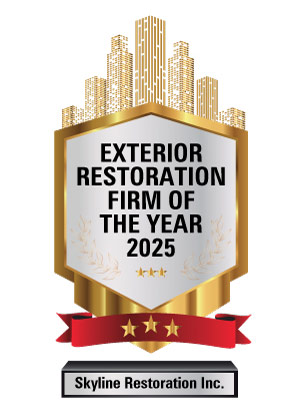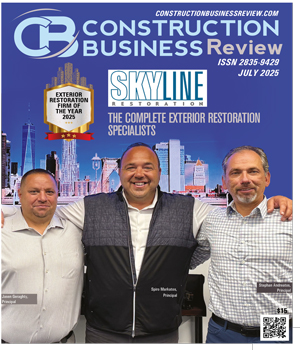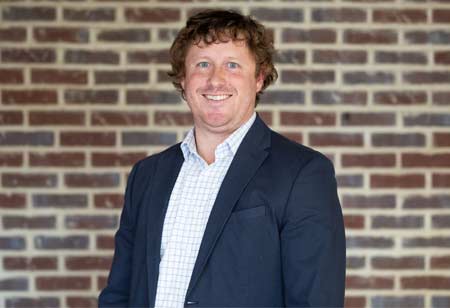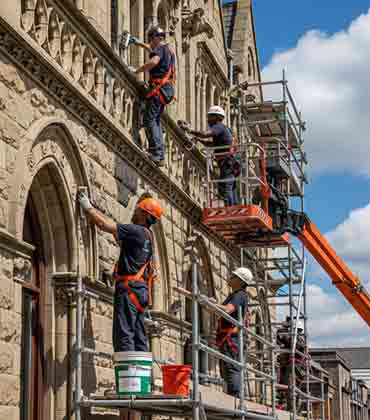Thank you for Subscribing to Construction Business Review Weekly Brief
New York City’s skyline is home to some of the most iconic architectural landmarks in the country. Preserving these structures requires deep expertise, precision, and dedication. For over 35 years, Skyline Restoration Inc. has been a trusted leader in exterior building restoration, helping ensure that the city’s architectural legacy endures. Specializing in commercial, residential, and institutional properties, Skyline breathes new life into aging facades while preserving historic character and tackles modern construction repairs with equal skill. The firm is known for its craftsmanship, problem-solving, and rigorous adherence to safety and compliance. Its teams are proficient in façade, roofing, waterproofing, and concrete restoration, managing every aspect of the building envelope. “Clients frequently turn to our expertise early in the process, particularly when planning complex historical landmark restorations,” says Spiro Markatos, principal. A Full-Spectrum Partner in Building Envelope Services Skyline works with a wide client base, including property owners, co-ops/condos, A/E firms, CMs, and more, navigating regulatory complexities like the NYC Department of Buildings’ Façade Inspection & Safety Program (FISP), formerly Local Law 11. As FISP guidelines evolve, property owners face shifting standards in budgeting, inspections, and long-term planning. More than a restoration contractor, Skyline offers a full-service operation. Its in-house FISP and historical divisions handle compliance, while its industrial rope access team enables inspections and emergency repairs that many firms can’t perform. The safety department, led by veterans of emergency response units, proactively inspects every site before, during, and after construction to protect both workers and occupants. Skyline’s integrated systems division manages larger-scale rehab projects, overseeing everything from interior renovations to roofing, MEP systems, and more. What sets Skyline apart is its internal cohesion. Many projects occur in occupied spaces, requiring precise coordination across departments to minimize disruption. “The challenges of coordinating and scheduling restoration projects in active spaces make the work we do unique in the marketplace,” says Jasen Geraghty, principal. With nearly 200 field workers, 50 office staff, 9 project managers, and supporting assistant managers, the Skyline team operates as a unified force. The firm also employs nearly 250 workers via subcontractors and works with various specialty firms for work involving hazardous materials or niche certifications. Where Rapid Response Meets Precision Execution Skyline’s expertise was put to the test during a large-scale Brooklyn project: a three-winged, 33-story tower with a deteriorating façade. Just one week before the scheduled start date, disaster struck; there was a partial collapse of a 40x10-foot section of wall on the 23rd floor.
Top Commercial Building Monitoring and Inspections Services 2025
A building isn’t complete when the final beam settles into place or the last coat of paint dries. It’s complete when it can reliably protect the lives inside. Every commercial space reaches a critical juncture before handover when fire alarms must trigger, elevators must respond and life safety systems must perform exactly as designed. At this decisive moment, precision and accountability define success. Sound Monitoring has built its 45-year reputation on making that decisive difference. From high-rise complexes in the Pacific Northwest to commercial developments in New York, Florida and nationwide, the company provides seamless transitions. Developers, owners and property managers trust Sound Monitoring not merely to pass inspections but to deliver absolute certainty—every system, every time. Behind this certainty is an uncompromising, entirely inhouse approach. One experienced team manages the entire process from installation, testing and technical support to compliance documentation and continuous monitoring. No subcontractors or fragmented responsibilities complicate the process; one accountable partner guides the project from construction through occupancy. An integrated model like this accelerates timelines, closes communication gaps and eliminates costly surprises. Fire alarms, elevators, Area of Refuge (AOR) systems and emergency communications, each critical safety component, are activated, tested, synchronized and certified inspection-ready—on schedule, the first time. “What we offer is dependability,” says owner Steve Burdine. “Building managers know that when something breaks or a deadline tightens, they don’t need to chase contractors. One call to us and it’s handled.” Sound Monitoring’s involvement starts well before buildings near completion. Its team proactively coordinates with contractors by tracking permits and construction milestones, locking down schedules and resolving potential issues early. This strategic lead time prevents disruptions and eases pressure as well as keeps completion dates on track..
Best Commercial Contractor 2025
Not every company makes it past a decade, let alone a century. Longevity in business isn’t just about staying afloat—it’s about adapting and proving relevance repeatedly. The Whiting-Turner Contracting Company has done precisely that. Founded in 1909, it started as a modest construction firm and grew into one of the most trusted names in construction. Not because it chased headlines or expanded recklessly but because it understood something fundamental: trust is built over time and reputation is earned on the ground, one project at a time. Its footprint is everywhere—hospitals, universities, data centers, government buildings. The work speaks for itself. Whiting-Turner doesn’t just construct buildings; it builds infrastructure that industries rely on, that cities grow around and that companies depend on to function. This is not a firm that dabbles in trends. It takes on projects that demand precision and accountability. From Concept to Completion A hospital expansion that must remain operational mid-construction. A data center where a single delay costs millions. A mixed-use development in a dense city, where logistics are as complex as the build itself. These projects don’t allow for mistakes. They demand seamless coordination, where every moving part fits without friction. For such clients, the process begins long before the first shovel hits the ground. It engages stakeholders early, working backward from client needs rather than imposing a standard approach. Whiting-Turner balances function, cost and long-term impact, ensuring each project is purposefully built.
CXO INSIGHTS

Harnessing the Power of BIM Technology to Optimize Collaborative, Successful Projects
Tom Perry, Managing Director of Engineering Services, Shawmut Design and Construction

A Proven Method for Success during a Challenging Time for Projects
Lee Sellenraad, Principal, Director - US Industrial Project and Program Management, Avison Young Consulting

Prefabrication, Modelling, and the Modular Future of Electrical and Intelligent Transportation Systems in Construction
Daniel Cole, PMP, Senior Project Program Manager, Aldridge Electric, Inc

Crafting Exceptional Residential Environments
Desmond Shotwell, National Director of Renovations, AMLI Residential

Making a Case for Young Leadership
Sara Marlow, Director of Architecture, CSM Corporation

Delivering More: The Foundation of Trust in Construction
Joffrion Beasley, Director of Quality Control, Chamberlin Roofing & Waterproofing
IN FOCUS
EDITORIAL
The New Era of Building Maintenance and Restoration
Emerging technologies are rapidly transforming the commercial building monitoring and exterior restoration industry, fueling significant growth and setting new standards for efficiency and precision. What was once a largely manual, reactive process is evolving into a data driven, proactive one. Drone inspections now offer safe, high-resolution visual assessments without disrupting operations. IoT sensors provide continuous, real-time monitoring of structural health. Predictive analytics enable early detection of potential issues, reducing long-term costs. Meanwhile, 3D imaging and digital twin models are enhancing diagnostic accuracy and planning. Together, these advancements are reshaping how commercial buildings are maintained, restored and safeguarded for the future. This edition of Construction Business Review brings recent developments in the building monitoring and restoration space into focus, highlighting key innovators, emerging technologies, and best practices that are setting new benchmarks for performance, sustainability, and long-term asset value. It features thought leadership articles from industry experts, including Daniel Cole, senior project program manager at Aldridge Electric, Inc., who explores the evolution and growing impact of prefabrication in the electrical and Intelligent Transportation Systems sectors, particularly in transportation construction. Rob Miller, VP of safety at Keeley Construction, highlights the importance of building trust, developing relationships, and empowering craft personnel to improve safety, quality, and productivity in the construction industry. It also features Skyline Restoration Inc., a leading exterior restoration firm based in New York City, specializing in the repair and preservation of building envelopes. We hope this edition provides valuable insights and practical guidance to help you navigate the rapidly evolving landscape of commercial building maintenance and restoration.









